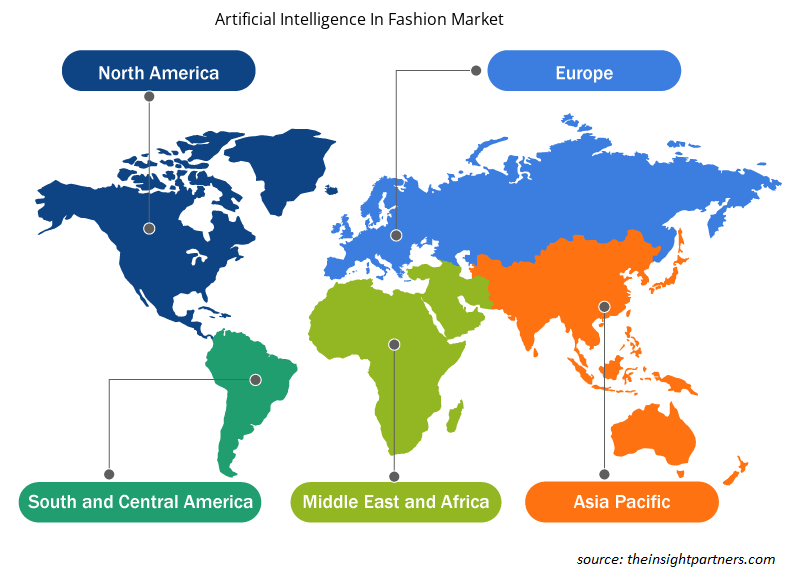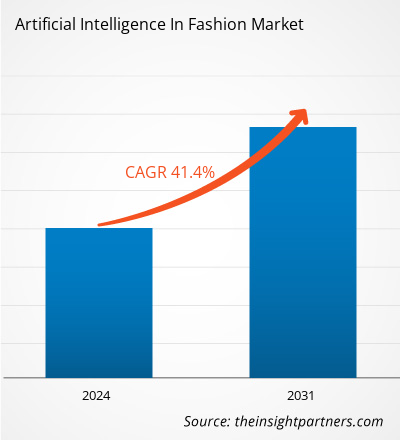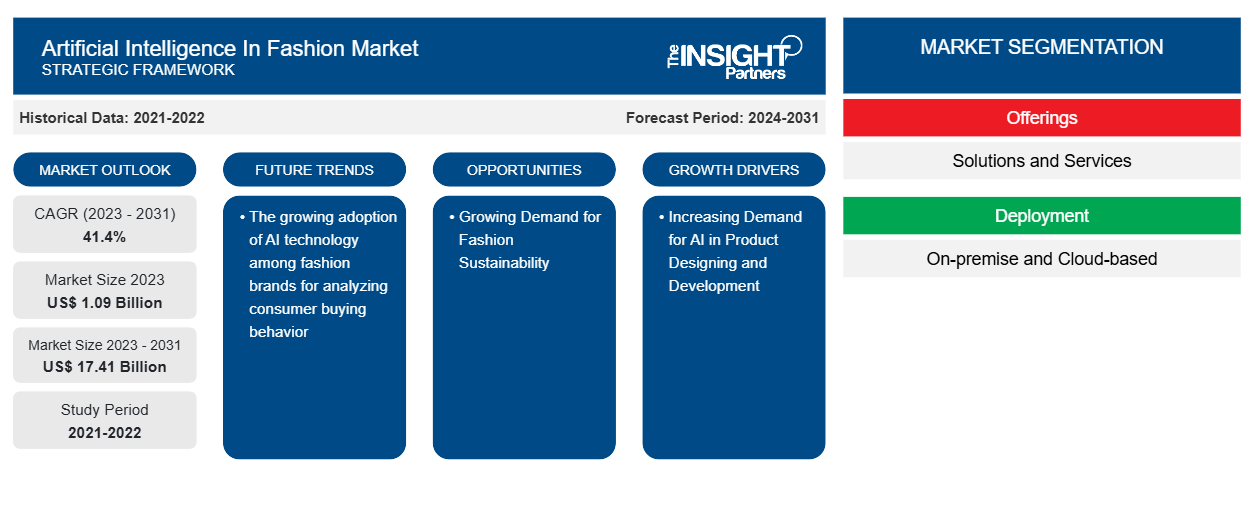预计到 2031 年,时尚人工智能市场规模将从 2023 年的 10.9 亿美元增至 174.1 亿美元。预计 2023-2031 年市场复合年增长率将达到41.4%。时尚品牌越来越多地采用人工智能技术来分析消费者购买行为,这可能仍是时尚市场人工智能发展趋势的关键。
人工智能在时尚市场分析中的应用
由于产品设计和开发对人工智能的需求不断增加,以及客户对个性化体验的需求不断增加,时尚市场的人工智能正在快速增长。受库存管理对人工智能需求不断增长的推动,市场正在稳步扩张。此外,对时尚可持续性的需求不断增长以及快时尚零售的增长为市场增长提供了有利可图的机会。
人工智能在时尚市场的概述
人工智能正在改变时尚行业,它改善了产品生命周期的许多方面,重新定义了服装的生产、销售和穿着方式。这项尖端技术为设计师、零售商和消费者提供了变革性的能力。时装设计师利用人工智能最大限度地发挥他们的创造潜力,推动设计创新。设计师可以使用人工智能算法检查大量历史时尚数据并识别时尚行业的潜在趋势,从而产生新的创新想法。
人工智能推荐系统可根据个人兴趣提供个性化产品建议,从而改善客户购买体验。人工智能支持时尚品牌评估浏览历史、购买行为和风格偏好等用户数据,并根据消费者的品味和兴趣创建个性化建议。这种定制可提高客户参与度、建立品牌忠诚度并提高销售转化率。
定制此报告以满足您的需求
您可以免费定制任何报告,包括本报告的部分内容、国家级分析、Excel 数据包,以及为初创企业和大学提供优惠和折扣
-
获取此报告的关键市场趋势。这个免费样品将包括数据分析,从市场趋势到估计和预测。
人工智能在时尚市场的驱动因素和机遇
产品设计和开发对人工智能的需求不断增长,推动市场发展
人工智能在时尚行业的产品设计和开发中发挥着重要作用。该行业将人工智能工具彻底融入到创意流程中,以简化和改进许多设计方面,提高效率并鼓励整个产品生命周期的创新。人工智能在产品设计中被广泛用于模式优化,而最大限度地提高材料效率正在推动市场的发展。人工智能算法检查设计标准和材料质量,以开发最佳模式,减少浪费,同时最大限度地提高资源利用率。该技术还可以帮助设计师在保持设计完整性的同时实现成本节约和环境可持续性目标。预计这些因素将在预测期内推动市场发展。
时尚可持续性需求不断增长——时尚市场人工智能带来的机遇
时尚行业越来越关注可持续方法和道德材料采购。人工智能在促进产品可持续材料的选择方面发挥着重要作用,为时尚公司提供重要的见解和帮助。人工智能算法在评估材料的可持续性时有助于检查许多要素。这些要素包括道德采购程序、成本效益考虑和环境影响研究。通过评估大型数据集和复杂因素,人工智能使时尚公司能够对其产品中使用的材料做出明智的决策,并平衡可持续发展愿望与业务目标。
此外,消费者意识的提高和对环境问题的关注也推动了人工智能算法的采用,以满足对可持续时尚日益增长的需求。消费者对服装对环境影响的担忧日益增加,这促使时尚品牌在整个制造和供应链中实施可持续做法。这些因素为市场创造了巨大的增长机会。
时尚市场人工智能报告细分分析
有助于时尚市场分析人工智能的关键部分是产品、部署、应用和最终用户行业。
- 根据产品,时尚市场中的人工智能分为解决方案和服务。解决方案部分在 2023 年占据了更大的市场份额。
- 根据部署方式,市场分为本地部署和基于云的部署。2023 年,基于云的部署将占据更大的市场份额。
- 根据应用,时尚市场的人工智能分为产品推荐、虚拟助手、产品搜索和发现、创意设计和趋势预测、客户关系管理等。产品推荐部分在 2023 年占据了更大的市场份额。
- 从终端用户行业来看,时尚市场的人工智能分为服装、配饰、化妆品等。2023 年,服装行业占据了更大的市场份额。
人工智能在时尚市场的地域份额分析
时尚市场人工智能报告的地理范围主要分为五个地区:北美、亚太、欧洲、中东和非洲、南美/南美和中美。
就收入而言,由于时尚行业越来越多地采用人工智能技术,北美市场占据了时尚人工智能市场份额的最大份额。技术改进和人工智能在时尚应用中的早期使用正在推动市场的发展。同样,美国和加拿大等国家的新兴时尚趋势也对人工智能技术的需求激增,以提高生产力、优化销售和可持续发展。此外,时尚行业的动态性质和消费者需求的不断变化也增加了对人工智能的需求,以推动创新和竞争。
人工智能在时尚市场的区域洞察
Insight Partners 的分析师已详细解释了预测期内影响时尚人工智能市场的区域趋势和因素。本节还讨论了北美、欧洲、亚太地区、中东和非洲以及南美和中美洲的时尚人工智能市场细分和地理位置。

- 获取时尚市场人工智能的区域特定数据
时尚市场人工智能报告范围
| 报告属性 | 细节 |
|---|---|
| 2023 年的市场规模 | 10.9亿美元 |
| 2031 年市场规模 | 174.1亿美元 |
| 全球复合年增长率(2023 - 2031) | 41.4% |
| 史料 | 2021-2022 |
| 预测期 | 2024-2031 |
| 涵盖的领域 |
按奉献
|
| 覆盖地区和国家 |
北美
|
| 市场领导者和主要公司简介 |
|
时尚市场参与者密度中的人工智能:了解其对商业动态的影响
人工智能在时尚市场的发展十分迅速,这得益于终端用户需求的不断增长,而这些需求又源于消费者偏好的不断变化、技术进步以及对产品优势的认识不断提高等因素。随着需求的增加,企业正在扩大其产品范围,进行创新以满足消费者的需求,并利用新兴趋势,从而进一步推动市场增长。
市场参与者密度是指在特定市场或行业内运营的企业或公司的分布情况。它表明在给定市场空间中,相对于其规模或总市场价值,有多少竞争对手(市场参与者)存在。
在时尚人工智能市场运营的主要公司有:
- Adobe 公司
- Alphabet Inc.(谷歌)
- 亚马逊公司(Amazon.com, Inc.)
- 华为技术有限公司
- IBM 公司
- 微软公司
免责声明:上面列出的公司没有按照任何特定顺序排列。

- 了解时尚市场人工智能顶级关键参与者概况
时尚市场中的人工智能新闻和最新发展
时尚市场中的人工智能是通过收集一手和二手研究后的定性和定量数据来评估的,其中包括重要的公司出版物、协会数据和数据库。以下是时尚人工智能市场的发展和战略列表:
- 2023 年 3 月,LS&Co. 宣布与数字时尚工作室 Lalaland.ai 建立合作伙伴关系,该工作室专门构建定制的 AI 生成模型。两家公司都计划测试和使用 AI 生成的模型来补充人类模型,以可持续的方式增加产品模型的数量和多样性。(来源:LS&Co.,新闻稿,2023 年)
时尚市场人工智能报告覆盖范围和交付成果
“时尚人工智能市场规模和预测(2021-2031)”报告对以下领域进行了详细的市场分析:
- 范围内所有主要细分市场的全球、区域和国家层面的市场规模和预测
- 市场动态,如驱动因素、限制因素和关键机遇
- 未来的主要趋势
- 详细的 PEST/波特五力分析和 SWOT 分析
- 全球和区域市场分析涵盖关键市场趋势、主要参与者、法规和最新市场发展
- 行业格局和竞争分析,涵盖市场集中度、热点图分析、知名参与者和最新发展
- 详细的公司简介
- 历史分析(2 年)、基准年、预测(7 年)及复合年增长率
- PEST和SWOT分析
- 市场规模、价值/数量 - 全球、区域、国家
- 行业和竞争格局
- Excel 数据集
近期报告
客户评价
购买理由
- 明智的决策
- 了解市场动态
- 竞争分析
- 客户洞察
- 市场预测
- 风险规避
- 战略规划
- 投资论证
- 识别新兴市场
- 优化营销策略
- 提升运营效率
- 顺应监管趋势























 获取免费样品 - 时尚市场中的人工智能
获取免费样品 - 时尚市场中的人工智能